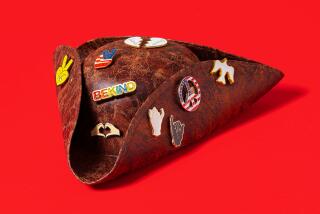Calling a Racist by His Proper Name : THE FRIENDSHIP<i> by Mildred D. Taylor; pictures by Max Ginsburg (Dial: $11.95; 56 pp.; illustrated; ages 7-11) </i>
- Share via
Cassie Logan, the outspoken black heroine of three earlier novels by Mildred D. Taylor including the Newbery Award-winning “Roll of thunder, Hear My Cry,” reappears in Taylor’s new story. But here Cassie is only 9 years old and plays a relatively minor role.
The central character this time is Mr. Tom Bee, an old fisherman and a friend to Cassie and her three brothers, Stacey, Christopher-John, and Little Man. As the children watch through the open door of the Wallace general store, Mr. Tom does what no other black in their rural Mississippi town would have dared to do in that year of 1933: He calls the white owner of the store, Mr. John Wallace, by his first name. “Well, howdy there, John!” he exclaims. “Glad ya finally done brought yourself on in here! These here boys-a yours ain’t been none too friendly.”
Wallace fills Mr. Tom’s order but warns him never to call him John again. “I’m losin’ face,” he says. Later, the children ask Mr. Tom how he had the nerve to challenge Wallace, and the old fisherman explains that, when Wallace was a boy, he saved his life not once, but twice.
Wallace said he’d never forget what Tom had done for him. But when he came back from Vicksburg and opened his store, he expected Tom to call him “Mr. Wallace” like all the other blacks. Tom went along with it for years, but now he’s decided to confront his old friend. He tells Cassie and the others: “I figures I’m close ‘nough to meetin’ my Maker, it don’t much matter he likes it or not.”
It does matter, though, as Mr. Tom discovers when he returns to the store for the tobacco he forgot earlier. He calls Wallace “John” again, this time before an audience of lounging white men. Embarrassed in front of his customers, and furious with Tom, Wallace takes a stand of his own. As Cassie and her brothers look on horrified, he grabs a gun and shoots Mr. Tom Bee in the leg. But the old man is still defiant. When he crawls off down the road at story’s end, he is shouting: “John! John! JOHN!”
Compact and tautly written, “The Friendship” conveys the threatening atmosphere of a hot summer day in the South of the 1930s. The dialogue brings the characters to flavorful life. And the story makes a powerful statement about black-white relations in a particular time and place.
Contributing to the book’s impact are the realistic black-and-white drawings by Max Ginsburg which are often reminiscent of movie stills from the period. (The illustrations contain one unfortunate error, however; the author says Mr. Tom Bee was shot in the right leg while Ginsburg pictures the wound in the left. Children will notice.)
Despite its many virtues, the book raises several troubling questions. Notwithstanding the presence of Cassie and her brothers, is it really a book for children? Is it a book at all, in fact, or is it rather an extended short story, and one with more meaning for adults?
There are no clear-cut answers to either of these questions, but one thing does seem certain: “The Friendship” merited publication, and it deserves to find a sizable audience--preferably among both children and adults.
More to Read
Sign up for our Book Club newsletter
Get the latest news, events and more from the Los Angeles Times Book Club, and help us get L.A. reading and talking.
You may occasionally receive promotional content from the Los Angeles Times.










